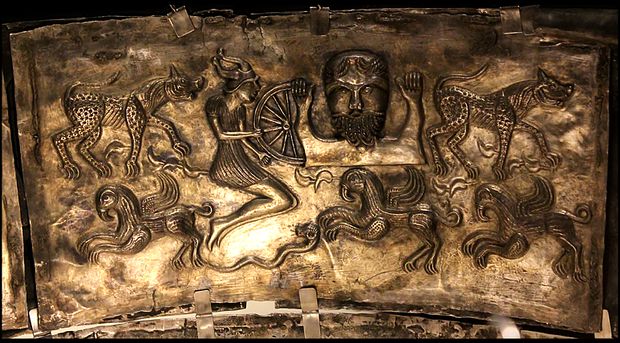タラニス
ケルト神話では、タラニス(Proto-Celtic: *Toranos, earlier *Tonaros; Latin: Taranus, earlier Tanarus)は雷神で、主にガリア、イスパニア、イギリス、アイルランドで崇拝され、ラインランドやドナウ地域などでも崇拝されていた。タラニスは、エスス、トータティスとともに、ケルトの神としてローマの詩人ルカヌスの叙事詩『ファルサリア』に登場し、人間の生け贄が捧げられたとされる[1]。タラニスは、ギリシャ神話のキュクロプス・ブロンテス(Cyclops Brontes、「雷」)と同様、車輪に関連していた。
ガリア地方からは、雷鳴と車輪を手にした髭のある神の像が多く出土しており、この神はジュピターと習合したようである[2]。
目次
名前と語源
原ケルト語では *Toranos('Thunder')と呼ばれ、これは原インド・ヨーロッパ語(PIE)の「雷」の語幹 *(s)tenh₂-から派生した *Tonarosのメタテーゼ(音の切り替え)により派生したものと推定されている。この名前の原型は、クルニア(Clunia、現在のブルゴス県)のローマ軍将校が奉納した祭壇に見られるtanaro(チェスター、AD154)というダブスタ形式と、ポー川(北イタリア)の古名であるガリア語のハイドロニムTanarus(「雷鳴」または「激しい」)で証明されている[3][4][5]。また、ヨーロッパの同種のヒドロニウムも同じルーツに属すると提唱されている[6]。PIEのs-initialは、ケルトベリアのsteniontes、stenion、stenaに残っているようである[7] 。
インド・ヨーロッパ語族の文脈では、原ケルト語の名前 *Tonarosは原ゲルマン語の雷神 *Þun(a)raz(cf. ON Þórr, OE Þunor, OS Thunar, OFris. Thuner, OHG Donar) と同じで、さらにサンスクリット語の stánatiやラテン語のtonoに関連していてどちらも「雷」を意味する[3][8]。学者ピーター・ジャクソンによれば、ケルト・ゲルマン語の異名詞 *Þun(a)raz ~ *Tonarosは、原インド・ヨーロッパ語の雷神 *Perkwunosのオリジナルのエピテーゼ(またはエピクレス)が化成した結果、生まれた可能性があるという[9][私注 1] 。
後の形である*Toranosは、ガリア人の神名TaranisとTaranucnos、および人名Taranutiusに記録されている。ピクト人の王命表の先史時代のセクションに登場するTaranという名前も、神格化された王として解釈することができるかもしれない。ヒスパノケルト語のtar(a)nekūmは「Tar(a)nosの子孫の」という意味かもしれない[10]。
また、中世のケルト語には、古アイルランド語のtorann(「雷、音」)、古ブルトン語のtaran、古コーニッシュ語のtaran、中ウェールズ語のtaran(「雷の音、雷鳴」)などの同義語も見られる。ガリア語で「雷」を意味する言葉は、ガスコーニュ語のtaramに残されている[3][11][8]。
車輪との関連性
車輪、特に6本または8本の輻を持つ戦車の車輪は、歴史的なケルトの多神教において重要な象徴であり、車輪神として知られる特定の神と関連していたようだ。その名は空、太陽、または雷神として確認されており、ルカヌスはタラニスと記している[12]。ケルトの硬貨にもこのような車輪が多数描かれている。グンデストルップの大釜の「割れた車輪」のプレートに描かれている半輪にも、8本の輻が見える(Citation needed, November 2019)。
シンボルとしての奉納輪は、中世青銅器時代からアレシアのような神殿に奉納されたり、セーヌ川のような川に流されたり、墓に埋められたり、お守りとして身につけられたりした。
Symbolic votive wheels were offered at shrines (such as in Alesia), cast in rivers (such as the Seine), buried in tombs or worn as amulets since the Middle Bronze Age.[13] Such "wheel pendants" from the Bronze Age usually had four spokes, and are commonly identified as solar symbols or "sun crosses". Artefacts parallel to the Celtic votive wheels or wheel-pendants are the so-called Zierscheiben in a Germanic context. The identification of the Sun with a wheel, or a chariot, has parallels in Germanic, Greek and Vedic mythology (see sun chariot).テンプレート:Citation needed
グンデストルップの大釜
割れた車輪。このプレートには髭のある人物が描かれており、割れた車輪を持っている。角のあるヘルメットを被った飛び跳ねたポーズの人物も車輪の縁を持っている。飛び跳ねている人物の下には角のあるヘビが描かれている。周囲にはグリフォンなどの生き物が描かれている。車輪のスポークは等間隔ではないが、下半分の描き方から全部で12本のスポークがあると推定される。ケルト起源説では中央の人物像をダグザだとしている。
Later cultural references
In 2013 a British combat drone system developed by defence contractor BAE Systems was named Taranis in reference to the Celtic god.[14]
Taranis and Toutatis are often mentioned by characters of the Asterix series.[15]
Taranis and other Celtic gods are often referred to in the EPIX television series Britannia
MacG Racing have developed a racing car called the Taranis racing in the British Endurance Championship[16]
参考文献
- Wikipedia:グンデストルップの大釜(最終閲覧日:22-11-18)
- Wikipedia:Chaudron de Gundestrup(フランス語版)(最終閲覧日:22-11-18)
See also
Footnotes
References
- Ellis, Peter Berresford, Dictionary of Celtic Mythology (Oxford Paperback Reference), Oxford University Press, (1994): ISBN 0-19-508961-8
- テンプレート:Cite book
- MacKillop, James. Dictionary of Celtic Mythology. Oxford: Oxford University Press, 1998. ISBN 0-19-280120-1.
- Wood, Juliette, The Celts: Life, Myth, and Art, Thorsons Publishers (2002): ISBN 0-00-764059-5
Further reading
- Gricourt, Daniel; Hollard, Dominique. "Taranis, caelestiorum deorum maximus". In: Dialogues d'histoire ancienne, vol. 17, n°1, 1991. pp. 343–400. [DOI: https://doi.org/10.3406/dha.1991.1919]; [www.persee.fr/doc/dha_0755-7256_1991_num_17_1_1919]
- Gricourt, Daniel; Hollard, Dominique. "Taranis, le dieu celtique à la roue. Remarques préliminaires". In: Dialogues d'histoire ancienne, vol. 16, n°2, 1990. pp. 275–320. [DOI: https://doi.org/10.3406/dha.1990.1491]; www.persee.fr/doc/dha_0755-7256_1990_num_16_2_1491
External links
私的注釈
- ↑ それはどうだろうか?
参照
- ↑ M. Annaeus Lucanus. Pharsalia, Book I , https://web.archive.org/web/20060502115056/http://www.worldwideschool.org/library/books/lit/poetry/Pharsalia/chap1.html , 2006-05-02
- ↑ Paul-Marie Duval. 2002. Les Dieux de la Gaule. Paris, Éditions Payot.
- ↑ 3.0 3.1 3.2 Matasović, Ranko, https://books.google.com/books?id=YN_YPQAACAAJ, Etymological Dictionary of Proto-Celtic, 2009, Brill, isbn:9789004173361, pages384
- ↑ Koch, 2020, pp142–144
- ↑ Sutrop, Urmas. "Taarapita-the Great God of the Oeselians". In: Folklore: Electronic Journal of Folklore 26 (2004). p. 40
- ↑ Pedreño, Juan Carlos Olivares. "Los dioses soberanos y los ríos en la religión indígena de la Hispania indoeuropea". In: Gerión n. 18 (2000). p. 204. ISSN:0213-0181
- ↑ Koch, 2020, pp142–144
- ↑ 8.0 8.1 Delamarre, Xavier, https://books.google.com/books?id=C3BKPgAACAAJ, Dictionnaire de la langue gauloise: Une approche linguistique du vieux-celtique continental, 2008, Errance, isbn:9782877723695, pages290
- ↑ Jackson, Peter, 2002, Light from Distant Asterisks. Towards a Description of the Indo-European Religious Heritage, Numen, volume49, issue1, pages61–102, doi:10.1163/15685270252772777, issn:0029-5973, jstor:3270472
- ↑ Koch, 2020, pp142–144
- ↑ Koch, 2020, pp142–144
- ↑ https://books.google.com/books?id=km66Nu4d-34C&dq=Celtic+wheels&pg=RA1-PA117, Symbol and Image in Celtic Religious Art, isbn:9780415080767, Green Miranda, 1992
- ↑ テンプレート:Cite book
- ↑ Taranis stealth drone test flights successful.5 February 2014 - via {{{via}}}.
- ↑ テンプレート:Cite journal
- ↑ MacG Racing Taranis.{{{date}}} - via {{{via}}}.

